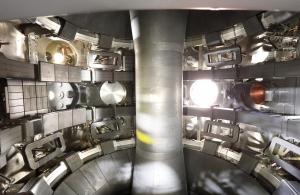MAST's divertor concept yields positive results
In tokamaks, the impurities and exhaust are driven to the divertor strike points at the bottom of the vacuum vessel for evacuation and recycling. In ITER, the divertor is the component that must resist the highest heat fluxes of the machine, as much as 20 MW per square metre (10 times the heat load of a spacecraft re-entering Earth's atmosphere).
High as that is, however, future tokamak reactors will have to cope with higher. Without an exhaust system that can handle the intense heat, materials will require regular replacement—affecting the amount of time the reactor can remain on line.
MAST Upgrade is a spherical tokamak at the Culham Centre for Fusion Energy (UK) that is exploring the route to compact fusion power plants. Since beginning operation in October 2020, it has been testing a new type of exhaust system, called the "Super-X divertor,"—a technology originally developed by the University of Texas. This unique component is designed to spread the arriving heat over a much larger area, increasing the distance the evacuating particles have to travel to be exhausted and injecting a gas to bring the temperatures down (see an animation of the Super-X divertor on the MAST Upgrade website).
Super-X has already demonstrated at least a tenfold reduction in the heat on divertor materials—"from a blowtorch level down to more like that you'd find in a car engine," says MAST Upgrade's Lead Scientist Andrew Kirk in a report published this month.
Results from the MAST Upgrade campaigns will inform the ongoing design of the European demonstration power plant, DEMO, although a Super-X divertor is not currently planned in the baseline design of that device. Results will also be followed closely by the team designing STEP (Spherical Tokamak for Energy Production)—the UK Atomic Energy Authority's program to design and construct a prototype of a compact fusion energy plant.
Read the original article on the MAST Upgrade website.
Read about the MAST Upgrade opening ceremony held on Wednesday 26 May 2021.


